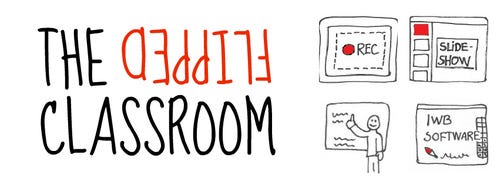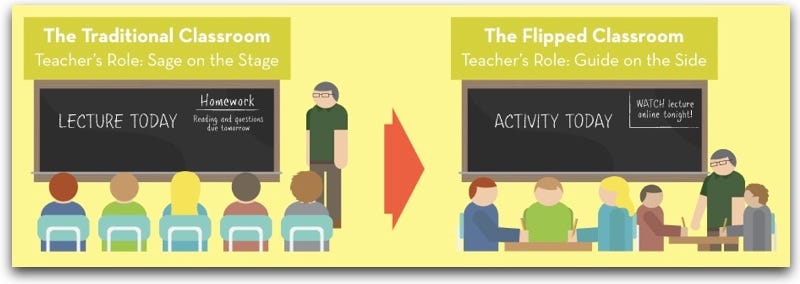School Leadership 2.0
A Network Connecting School Leaders From Around The Globe
5 Myths of Classroom Flipping
5 Myths of Classroom Flipping

Most ‘alternative’ education initiatives stay exactly that: alternative. No matter how noble their intentions, they remain in the minority, exceptions to the rule. However, in very recent years one education concept has broken through and become mainstream.
Many excellent explanations have already been written about classroom flipping, including concise ones such as this, and thorough ones with associated resources such as this. For the uninitiated, either of these are well worth a read before continuing.
The model has developed over time and there are a myriad of iterations. Common to all variants, though, is that students use class time to interact with learning material through inquiry, analysis and creation. The educator’s delivery of that material — the ‘lecture’ — would have been occupying class time in the traditional model, but in a flipped classroom model the lecture instead is accessed by the student in their own time prior to the class, often through online means such as podcasts and instructional videos.
Within western higher education, it is now more common to find a course with a flipped classroom than an unflipped one. By 2016, 55% of US college faculties were flipping their classroom. That reach is only growing: statistically, geographically and even breaching secondary education.
It is liked, too. Scholarly research indicates that the majority of applications of flipped classrooms are met with wide acclaim. Approval and recommendation ratings tend to lie above 90% amongst both students and instructors, reaching 99% in some cases.
But with sudden popularity, come myths. All of them slow the continued, healthy growth of the practice. Here are five:

Myth One:
The educator must record their own material
Creating engaging audio and video content is a tricky skill that goes beyond just technical aptitude. Training is required. Some educators still may not be comfortable doing it.
So what are their alternatives if they still want to flip?
If the educator wants to create their own material for their class in order to keep it personal but are not ready to record themselves, then they can give their students other resources such as annotated photocopies of textbooks or a powerpoint presentation to go through before class.
If the educator likes the idea of using video — just not their own — then there is no shortage of pre-prepared material already available online, meaning they can effectively team up with some of the world’s leading authorities on their topics.
Myth Two:
This must be an upheaval
Adopting a new model can be daunting, but the good news is that classroom flipping can be adopted one step at a time.
An educator can start by flipping a single lesson, perhaps by guiding their students to a Youtube video and a set of pre-prepared comprehension questions to accompany it. In class, they can have a group discussion about the topic followed by a written exercise where the educator can occupy the role of ‘guide on the side’. If it went well, more lessons can gradually be flipped. I am a teacher and this is what I did. Now I run some of my lessons the traditional method and I flip a few when appropriate. My department head ensures I am still in line with the curriculum and my colleagues. It can be a low stress process.
Myth Three:
It is a drain on teacher time
This is a common concern and has historically been one of the biggest obstacles to the model’s uptake. Teacher time is notoriously tight and any concerns should indeed be taken seriously. Every educator should be convinced that they will ‘get back’ the hours they initially spend on flipping their lessons, and that assurance should be explicitly built into the plan before rolling out the new method across a department or institution.
For instance, if a teacher does choose to spend time recording their own video, then they should be able to re-use it in future years. A potential timesaver they may find arising as a result of having flipped that class is that they may not need to spend so long correcting mistakes in the students’ written work, as there was more time in class to guide the students to give higher quality responses.
Myth Four:
This is a cost-cutting opportunity
This is a misjudgement, and one which the students never fall for. 1600 University of Central Florida Business students recently signed a petition, damning the new blended learning model, which included some classroom flipping, as it had patently reduced contact time with their professors.
The main reason that classrooms were ever flipped is that the model intends to maximise the limited contact time between student and teacher, not cut it. Rather than spending contact hours on the base cognitive action of listening to someone orate, flipped classrooms enable that time to be spent grappling with material on a deeper level with an expert at hand to martial and tutor. If those contact hours are cut, that benefit crumbles.
Myth Five:
Learning Outcomes will definitely improve
This myth creates false expectations which will ultimately reduce trust in the model.
Put simply, there is little evidence within peer-reviewed literature that suggests learning outcomes will significantly improve within a flipped classroom model when compared with a control which employs a traditional model with an active learning f.... There are incidents, but they are rare.
Flipped classrooms are, however, particularly effective ways of encouraging teachers to instil active learning if that is what was previously lacking. And active learning has been well proven to increase learning outcomes.

The flipped classroom model has boomed because it is so flexible. It can be adopted gradually and does not need to radically interfere with the educator’s existing pedagogical approach. It simply offers a potentially more effective method for them to do what they have always been doing anyway: delivering material to students for them to then interact with it. Time invested in creating or finding resources can be paid back because the ‘homework’ element is brought into class and that reduces marking obligations. The model waves no wand, but the active learning which it encourages should prove as popular as it is stimulating.
Mike Fisher
High School Teacher, Education Enthusiast
JOIN SL 2.0
SUBSCRIBE TO
SCHOOL LEADERSHIP 2.0
Feedspot named School Leadership 2.0 one of the "Top 25 Educational Leadership Blogs"
"School Leadership 2.0 is the premier virtual learning community for school leaders from around the globe."
---------------------------
Our community is a subscription-based paid service ($19.95/year or only $1.99 per month for a trial membership) that will provide school leaders with outstanding resources. Learn more about membership to this service by clicking one of our links below.
Click HERE to subscribe as an individual.
Click HERE to learn about group membership (i.e., association, leadership teams)
__________________
CREATE AN EMPLOYER PROFILE AND GET JOB ALERTS AT
SCHOOLLEADERSHIPJOBS.COM
New Partnership
Mentors.net - a Professional Development Resource
Mentors.net was founded in 1995 as a professional development resource for school administrators leading new teacher induction programs. It soon evolved into a destination where both new and student teachers could reflect on their teaching experiences. Now, nearly thirty years later, Mentors.net has taken on a new direction—serving as a platform for beginning teachers, preservice educators, and
other professionals to share their insights and experiences from the early years of teaching, with a focus on integrating artificial intelligence. We invite you to contribute by sharing your experiences in the form of a journal article, story, reflection, or timely tips, especially on how you incorporate AI into your teaching
practice. Submissions may range from a 500-word personal reflection to a 2,000-word article with formal citations.
You need to be a member of School Leadership 2.0 to add comments!
Join School Leadership 2.0